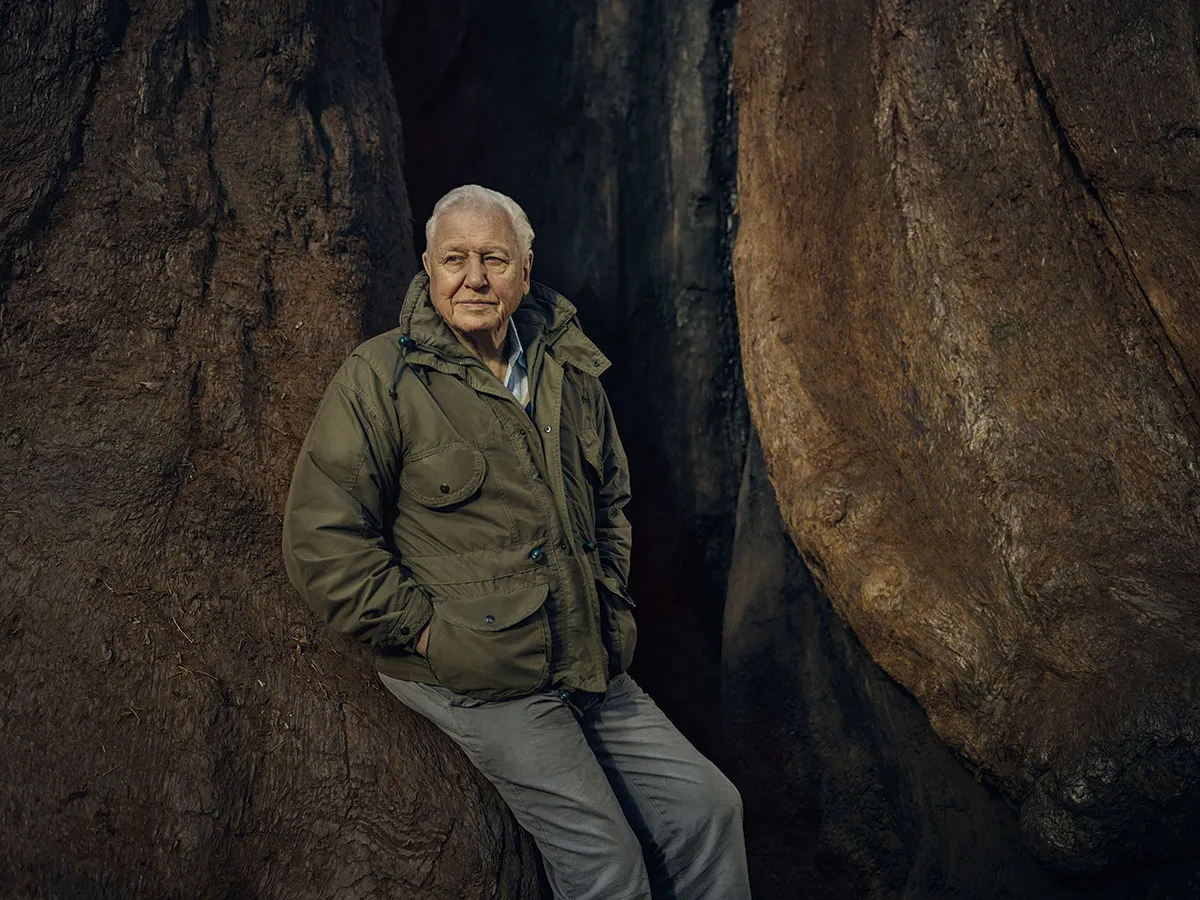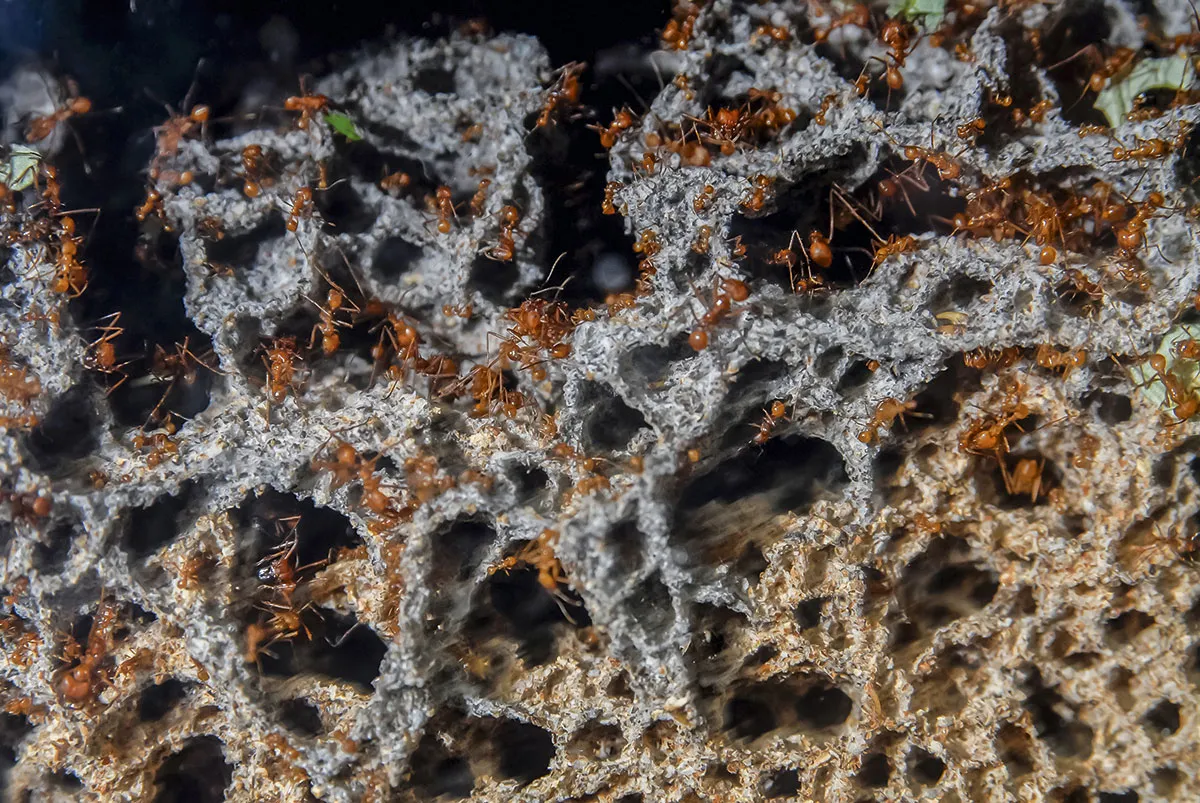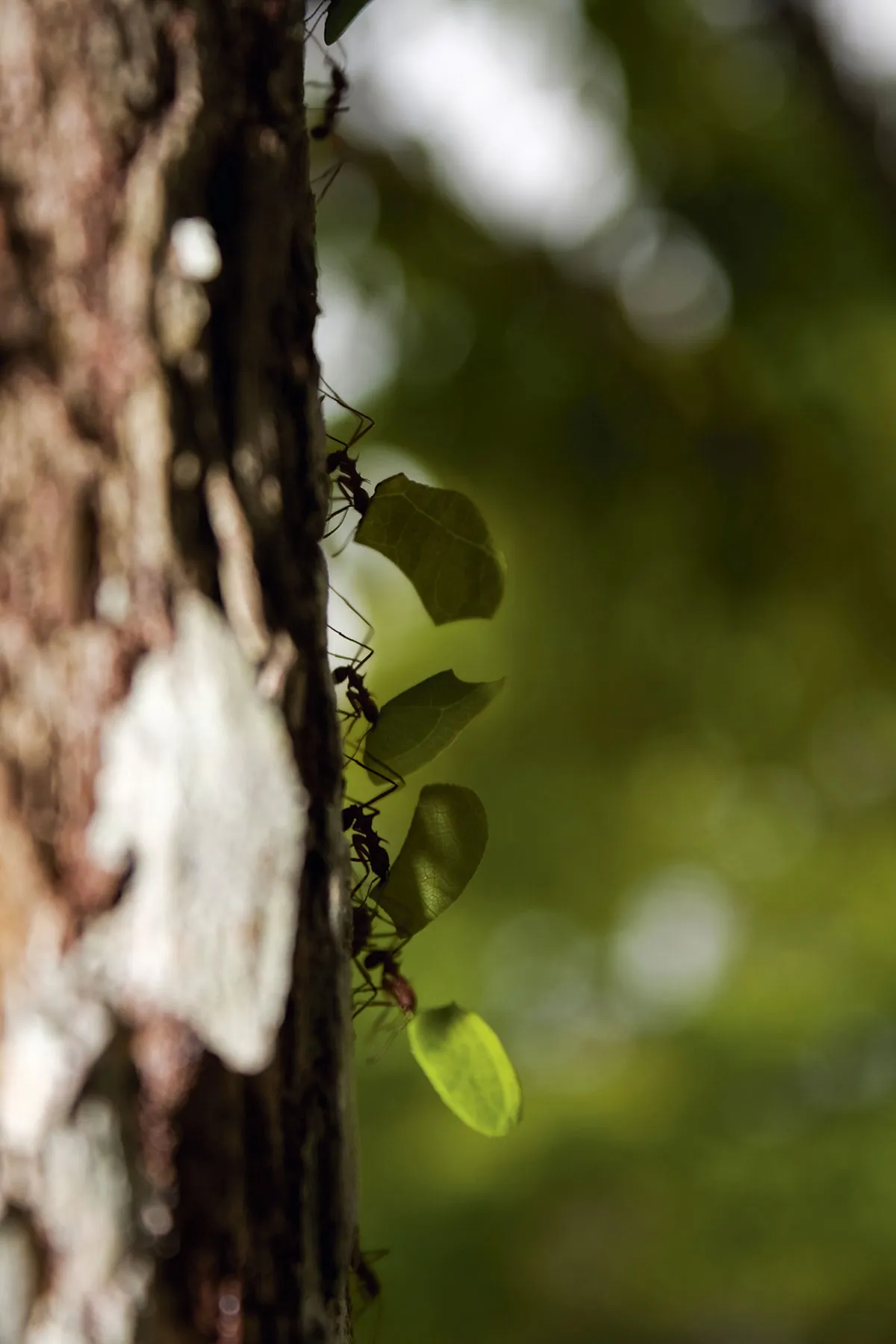Beneath the rainforests of South America lives a fungus that consumes 50,000 leaves a day without ever coming to the surface. It relies on ants to bring it food in exchange for nutrients. This unlikely partnership starred in Sir David Attenborough’s new wildlife series The Green Planet, available now on BBC iPlayer. Evolutionary biologist Dr Pepijn Kooij speaks to Amy Barrett about this special relationship.
The leaf-cutter ants rely on their fungus for food. Why don’t they just cut out the middleman and eat the leaves themselves?
Digesting plant material is a difficult process, even for us humans. It’s a hard thing to do.
Think about herbivores, carnivores and omnivores, and just look at, for example, the lengths of their intestines. If you take a tiger – a carnivore – the length of its intestines is about six metres. But if you look at a cow – the perfect example of a herbivore – the intestine is about 24 metres long, and cows also have multiple stomachs. It’s a long process to digest plant material, and you need lots of different bacteria to help you do it.
Plants have this defence mechanism: an enormous cell wall around their cells to protect them from being eaten. It takes a lot of energy to get to the parts in the plants that we actually need – the nitrogen and proteins. But there are specialised organisms, such as bacteria [in a cow’s stomach], that are designed to do that kind of work. For the ants, they want those proteins, but it’s very hard for the insects to actually extract them. So they have their fungus help penetrate the cell, then the ants feed on the fungus.

But doesn’t the fungus need the protein? Why would it share?
Well, the fungus takes some of the proteins, but it has developed this relationship with the leaf-cutter ants. The fungus grows specialised organs, which we call gongylidia. Inside the gongylidia are fats and proteins, which are nutritious for the ants. The ants eat these gongylidia.
But the fungus also benefits from this relationship. Usually, fungi need to release enzymes that let them break down plants to absorb the nutrients. With the leaf-cutter ant partnership, the fungus fills its gongylidia with enzymes. The ants eat these enzymes when they feed on the gongylidia, but theycannot digest them, so they are still active when the ants poo them out.
The ants will bring new plant material into the nest, place it on the fungus and then poo on top. This gets the fungal enzymes exactly where they need to be to break down the plants. The fungus is using the ants like trucks, to transport the enzymes from one part of the fungus to the place where the new plant material is located.
If you watch the first episode of The Green Planet, you’ll notice the fungus looks like a big ball. This ball is the fungus, made up of what’s called the mycelium.
These organisms are often called fungus-growing ants, but I think ant-growing fungi could be a better term.
Read more about fungi:
- Can the wood-wide web really help trees talk to each other?
- How most life on Earth is dependent on fungi – including you
- Five incredible facts about fungi we learned from Merlin Sheldrake
Ant-growing fungi?
So, ‘fungus-growing ants’ is term that the Royal Botanic Gardens, Kew, first used in the late 19th Century for these ants that farm fungi as their main food source. I’ve been trying to change the view more into ant-growing fungi.
This is a mutualism, and a mutualism has a benefit for both [parties]. To say that the ants are growing the fungus is a bit one-sided. Of course, they bring in the leaves and they grow the fungus on there. But the fungus is also directing and giving assignments to the ants somehow, using chemical communication. So you could also see it as ant-growing fungi.
It’s as if the fungus is using the ants, sort of like cattle. Seeing the system that way brings up lots of different questions. Our research is trying to untangle this whole system to see how it works. Because in the end, it’s a mutualism and you could even see that as one big organism.
In the same way, we humans have lots of bacteria in our guts, but we still see ourselves as one system. We wouldn’t say we are a human and bacteria. So in that sense, it’s not ants that grow fungus, it’s ants and fungus together.
You said the ball was mycelium. What is that?
You might’ve seen fungi in the form of a mushroom, but this is only a small percentage of the actual organism.
In a forest in England, for example, you might see mushrooms, but there will be metres and kilometres of mycelium underneath the soil that you don’t see.
This mycelium is much more important [than the mushroom] for the fungus. In fact, the mycelium is the actual fungus. The mushroom is only a sexual reproduction tool.
The best comparison you might make is something like an apple tree, with the apple that contains its seeds, or a plant’s flower and its pollen. So, the mushroom is then analogous to the flower and it creates the spores, which are like the pollen.
It’s only that small part of the fungus, the mushroom, that you actually see, which
is the most pretty part, of course. Though mycelium can look very pretty – I can tell you that with certainty. But in general, you can’t see the mycelium because it’s very thin, thread-like structures in the soil.
It’s the mycelium that extracts all the nutrients. It does all the hard work. And then bubbles together to form the mushroom.

Why don’t the ants just eat the mushroom?
Normally, this particular fungus doesn’t need to grow mushrooms for sexual reproduction, because the ants help spread the fungus.
Every generation of ants begins with a new queen, and the new queens will take a piece of the fungus into a special cavity in their mouth that they take away when they fly out to mate and start a new colony.
This is a process we call ‘vertical transmission’. It makes sure that there is a continuation of this particular strain of fungus without any genetic mixing.
Producing a mushroom requires a lot of energy that is wasted on something that’s unnecessary. Also, the ants can’t eat the mushrooms.
When I studied these [fungi] species in Copenhagen, we kept them in climate-controlled rooms. Sometimes the climate chambers had problems – a sudden decrease in temperature, or the humidifier might not be working very well – and we would get mushrooms. The ants would attack those mushrooms. They would cut away at the lamellae [gills] on the underside of the mushroom cap, where the spores are formed, and try to get rid of the mushrooms.
Now, in the campus where I am in Brazil, every now and then we see mushrooms coming up. It’s very, very strange to see. One of the PhD students that I started working with at São Paolo State University, Rodolfo Bizarria Jr, started counting how many times we saw this.
Then we went back through the literature to find all the occurrences [of mushrooms appearing]. There aren’t many, going back all the way to the 19th Century. But we can see an increase. We tried to determine whether there was a correlation with the temperature, the humidity and the precipitation, and there does seem to be a link.

Could climate change affect these species?
We don’t know yet. We just know there is an increase in mushrooms, and normally this is not profitable for the system. We would have to look into if this is going to be really detrimental for the colony.
Where is this fungi-ant system found?
Only in the Americas. So, you can find fungus-growing ants in the southern parts of South America, around Argentina and Chile, all the way up to the southern parts of the United States – Florida, Arizona, Texas. Even on the Caribbean islands you can find some of these species.
Why did this relationship begin?
That’s the big question. We don’t know. There are several different theories, and the most common is that it might have originated from ants that started collecting plant material as food. The ants deposited the material inside the nest chambers and then a fungus started growing on it, and somehow they realised, “Hey, this is nice!”
Kind of like how we discovered how to make beer, for example, or other alcoholic products, because fungi started growing on our rotting food and eventually we realised, “Oh, but that’s actually very nice.”
But the exact connection, we don’t know for sure. We know more about the ants because people have studied them more. So we’re much closer to understanding the ant ancestors than when we started doing this.
We don’t know what the closest ancestors of these fungi are. A key part of my research is trying to find that out and trying to understand why these ants chose this fungus and not another one. What is so good about these fungi and what is the origin of the fungus that is related to it, those that aren’t growing with ants? Once we know that we might be able to compare the genomics and the ecology. With that, at least, we can make some inference of how this all started.
But this isn’t just a relationship between ants and fungi. How have the plants adapted to protect themselves from being eaten?
Plants have their own defences, and they’re not necessarily particular to these ants, but a general protection against herbivores. One way they do this is by producing toxins, which we call phenolic compounds. Tannins are an example for that. So, if you have a nice glass of wine, the tannins in your mouth – the drying, bitter taste – are the defence mechanism of plants.
That acidity is very good at fending off any fungi, any bacteria – and with that any herbivores, because it would disrupt their microbiome.
However, another defence is other fungi. Inside plant leaves you’ll find what we call endophytes. These are fungi that form, in most cases, a mutualism with the plant, to protect it against herbivores. They would not like to have other fungi in their food!
Studies with leaf-cutting ants showed that when presented with leaves infected with endophytes, the ants would always go for the leaves that had the least. Because otherwise you might get competition between their fungus and the fungi in the leaf.

How do they know?
Good question. We think that the ants can smell it. They don’t have noses, of course, but with their antennae they’re able to pick up odours, chemicals and volatiles released by the plants or coming from the fungus. That’s another way the fungus communicates with its ant colony. The ants might give something to the fungus and the fungus can give off a signal that says, “I don’t like this one.”
Studies by a group in Germany gave the ants little pieces of leaves treated with fungicides. After 24 hours, the ants stopped bringing those to the fungus. It’s not that the ants that recognised the fungicide, but they recognised something was wrong because the fungus was not liking it. There’s a really tight interaction between the fungus and the ants.
- This article first appeared inissue 373ofBBC Science Focus Magazine–find out how to subscribe here
Read more about insects:
